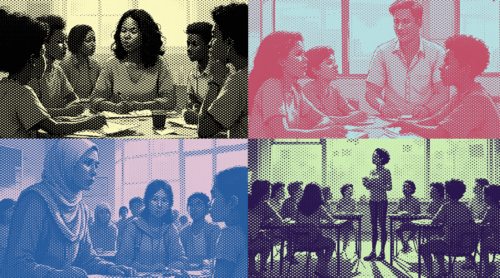Want a More Peaceful Classroom Now? Start with Conflict
- Kathleen Gordon
- with Tanja Hagedorn

Share
How do we teach young people to truly understand peace—not just the absence of fighting, but the presence of empathy, understanding and connection? One powerful way is to start by teaching them about conflict. In our Peace and Conflict module we introduce a simple but effective tool: The Conflict Tree.
Tanja, a Peacebuilder and educator, helps students explore what peace means and why it’s so hard to achieve without first looking at conflict. As she explains, ‘It’s really difficult to feel peaceful or to say sorry if no one understands why you’re angry or upset.’ This is the starting point for powerful learning: instead of rushing to fix surface-level problems, we go deeper.
What is the Conflict Tree?
The Conflict Tree is a visual and reflective tool to help young people analyse conflict. Here’s how it works:

The trunk represents the core disagreement.
The branches and leaves show what the conflict looks like on the surface—like shouting, crying, fighting, or silence.
The roots represent the causes—things that may not be immediately visible, such as misunderstandings, unmet needs, emotions, or even completely unrelated stressors.
Just like a real tree, if you only water the leaves or cut off branches, the tree might keep looking sick. Real healing and growth only happen when we understand what’s happening in the roots.
Bringing it to life: A story from the playground
During a school break, a fight breaks out over a soccer ball. Two boys end up on the ground while a crowd gathers. A teacher breaks it up and tells them to apologise and move on. But do they really feel peaceful afterwards?
Later, a different teacher takes the time to talk to the boys. Bit by bit, the real story emerges. One boy had brought the ball from home under pressure not to lose it. The other felt left out and ignored. Both were hungry. One was dealing with a big family change at home. The fight wasn’t just about a ball—it was about feeling worried, unheard and disconnected.
Using the Conflict Tree, this conflict is no longer about blame. It becomes an opportunity to understand, connect, and rebuild peace. In the end, the boys not only apologise, but show genuine care for one another.
Why this matters in the classroom
When we give students tools to understand conflict, we help them become more thoughtful, empathetic, and capable of resolving disagreements in a healthy way. It teaches them to:
- Recognise their own emotions and needs.
- Listen to others’ perspectives.
- See beyond the surface of an argument.
- Take steps that lead to lasting peace, not just quick fixes.
Building a culture of peace
By integrating peacebuilding tools like the Conflict Tree into classrooms, we can help students become better friends, better listeners, and better citizens. As Tanja says, ‘Understanding conflict gives us a better chance to build peace that is real and that will last longer.’
Go directly to the resource
About the Authors
Tanja is a peacebuilder, facilitator, and advocate for gender equity with over 25 years of experience working across diverse communities and global contexts. She is committed to creating inclusive spaces for dialogue, healing, and transformation—particularly where cultures, faiths, and identities intersect. With a Masters in Peace and Conflict Studies, her work and academic focus centre on empowering others, challenging injustice, and fostering sustainable social change.
Kathleen (she/her) is a former primary school teacher, born on Mandandanji Country in Roma and now living and working on Kabi Kabi/Gubbi Gubbi Country on the Sunshine Coast, Queensland. Her family came to Australia from Scotland and Ireland in the late 1800s. Kathleen’s work as an educator reflects her commitment to social justice, peace, democratic processes, and sustainability.
Copyright
Metadata © Together for Humanity (except where otherwise indicated). Digital content © Together for Humanity (except where otherwise indicated). Video © Together for Humanity (except where otherwise indicated). All images copyright their respective owners. Text © Together for Humanity is licensed under a Creative Commons Attribution-ShareAlike 4.0 International License (CC BY-SA 4.0).
Copyright
Metadata © Together for Humanity (except where otherwise indicated). Digital content © Together for Humanity (except where otherwise indicated). Video © Together for Humanity (except where otherwise indicated). All images copyright their respective owners. Text © Together for Humanity is licensed under a Creative Commons Attribution-ShareAlike 4.0 International License (CC BY-SA 4.0).
- Stage: All
- Curriculum: All
- Topics: Peace and conflict, Resilience
